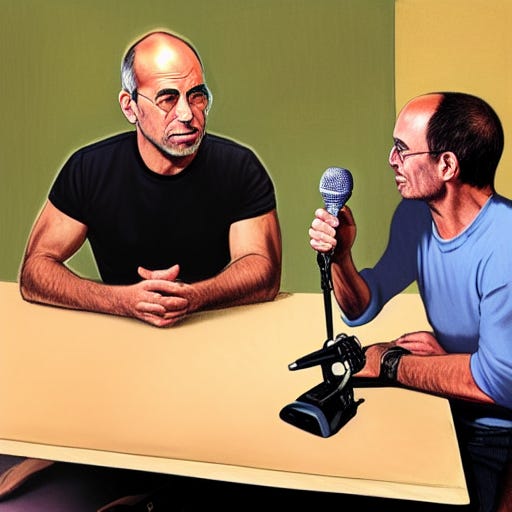What if Joe Rogan Interviewed Steve Jobs?
In the synthetic media realm this is possible and it now exists
If you read commentary about the new Podcast.ai show with a synthetic Joe Rogan interviewing a synthetic Steve Jobs, you are bound to come across something like it is “blowing people’s minds.”
How could this be? First, some context.
Play.ht is a Dubai-based startup with a text-to-speech engine. The company decided to create an entirely AI-generated fictional podcast to showcase its technology. The first episode features a synthetic Joe Rogan interviewing a synthetic Steve Jobs. This interview never happened in real life, but through the magic of voice clones and GPT-3, Podcast AI has offered us a captivating example of where media is headed next.
How realistic is it? There are three elements at play here: the fidelity of the base voice clones in terms of tone and style, the prosody of the speech, and what they say to each other. There is a lot of Joe Rogan audio data to pull from and plenty from Steve Jobs though not nearly as much. When you move to the content, they both have a record of sharing a lot about their thoughts on a variety of topics. That is a pretty good starting point.
Click the image to hear the episode.
What Does This Mean?
Most people see this as an interesting party trick. Others wonder whether this should be a warning about how synthetic media can be misused. I would like to direct you to my Synthedia post summarizing the key themes from the Synthedia 1 conference. One of those themes highlighted the twin benefits of hyper-automation and hyper-creation.
AI-based content generators can deliver far more output than humans in a given time period. That is the automation element. These systems can also create media that has never before happened and, in some cases, could never happen. That is a part of the hyper-creation benefit.
It is obvious that Joe Rogan could not interview Steve Jobs today as the latter passed away 11 years ago. Synthetic media offers the opportunity to create a facsimile of such an encounter. Hyper-creation refers to the scalable generation of novel content, just like what we are hearing from Podcast AI.
The synthetic interview is interesting. It’s also entertaining. What we have is a new set of tools for creatives. I am intentionally using the term creative and not creator. Creators are the center of their content creation. The content starts with them and projects outward. Cloning their voice and image likeness is the most obvious way for creators to leverage synthetic media to expand their reach and productivity.
The output or artifact is the center of the content for creatives. Creatives are not first and foremost influencers. They are filmmakers, artists, and musicians. Jean-Baptiste Martinoli’s award-winning AI-generated film is an example of output by a new kind of creative. Anne Spalter’s collection of 501 AI Spaceships generated using Night Cafe is an example of output from a traditional creative employing new tools.
More Novel Content is Coming
Podcast AI is another demonstration of how synthetic media tools can be employed to create novel content. Its goal is to promote Play.ht’s technology. Jean-Baptiste Martinoli’s first two AI films are designed to demonstrate what you can do when combining technologies from several services. Anne Spalter shows you how the mind of an artist can leverage AI to create a new form of art.
Syntethic media generation technologies (Text-to-X) are powerful, scalable, easy to use, and manifest intriguing content. This is true when they are used in isolation and even more so when used in combination. We are at the beginning of the beginning of this trend. Expect a Cambrian explosion of AI-generated content over the next two years.
More to come on this topic.





